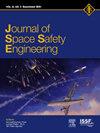基于虚拟连接数据集的航天器碰撞检测策略比较
IF 1.7
Q3 ENGINEERING, AEROSPACE
引用次数: 0
摘要
避碰领域的联合评估通常是基于单个或多个碰撞风险指标的融合。文献中提出了几种风险指标,但笔者尚未找到基于脱靶检测性能对这些指标进行比较研究的文献。在选择可操作阈值时,脱靶检测实际上是一个可能的目标参数,并且是高流量条件下的良好候选。这项工作应用并比较了四种不同的检测策略i)碰撞概率,ii)马氏距离,iii)沃尔德序列概率比测试和iv)高斯信念函数在虚拟连接的公共数据集上,测量接收机-工作特征(ROC)平面上的性能(检测率- vs -误报警率)。虚拟连接数据集在给定轨道场景的候选连接的几何形状和真实碰撞率方面提供了前所未有的真实感。使用该数据集,我们估计检测器的实际性能。结果表明,所有检测的风险指标都提供了与未检出率相关的性能。然而,相对于马氏距离检测器,经典的碰撞概率算法可能表现不佳,而马氏距离检测器可能因其简单而更受欢迎。本文章由计算机程序翻译,如有差异,请以英文原文为准。
A comparison of spacecraft collision detection strategies using a virtual conjunction dataset
Conjunction assessment in the field of collision avoidance is customarily based on a single or a fusion of collision risk indexes. There are several risk indexes proposed in the literature, yet the authors could not find a comparative study of such indexes that was based on the miss detection performance. Miss detection is in fact one possible target parameter when choosing an actionable threshold and is a good candidate for high-traffic conditions. This work applies and compares four different detection strategies i) Probability of Collision, ii) Mahalanobis distance, iii) Wald Sequential Probability Ratio test and iv) Gaussian Belief Function on a common dataset of virtual conjunctions, measuring the performance on the Receiver-Operating-Characteristic (ROC) plane (detection rate – vs – false alarm rate). The virtual conjunction dataset offers an unprecedented realism in both the geometry and the true collision rate of candidate conjunctions given some orbital scenario. Using this dataset, we estimate the realistic performance of the detectors. Results indicate that all the examined risk indexes offer a performance linkable to the miss detection rate. However, the classical Probability of Collision can underperform with respect to the Mahalanobis distance detector, which might be preferred for its simplicity instead.
求助全文
通过发布文献求助,成功后即可免费获取论文全文。
去求助
来源期刊

Journal of Space Safety Engineering
Engineering-Safety, Risk, Reliability and Quality
CiteScore
2.50
自引率
0.00%
发文量
80
 求助内容:
求助内容: 应助结果提醒方式:
应助结果提醒方式:


